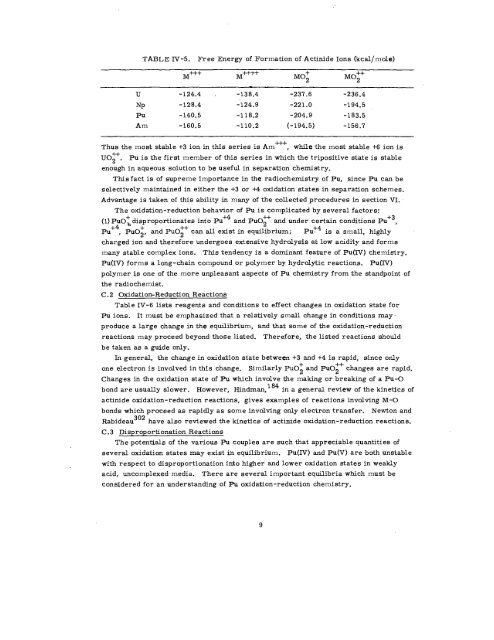THE RADIOCHEMISTRY OF PLUTONIUM - Sciencemadness.org
THE RADIOCHEMISTRY OF PLUTONIUM - Sciencemadness.org
THE RADIOCHEMISTRY OF PLUTONIUM - Sciencemadness.org
Create successful ePaper yourself
Turn your PDF publications into a flip-book with our unique Google optimized e-Paper software.
TABLE IY-5. Free Energy of Formation of Actinide Ions (kcal/mole)<br />
M +++<br />
M +t++<br />
MO; MO~<br />
u -124.4 -138.4 -237.6 -236,4<br />
Np -128.4 -124.9 -221.0 -194,5<br />
Pu -140.5 -118.2 -204.9 -183.5<br />
Am -160.5 -110.2 (-194.5) -156.7<br />
Thus the most stable +3 ion in this series is Am+ , wliie the most stable +6 ion is<br />
uo~. Pu is the first member of this series in which the tripositive state is stable<br />
enough in aqueous solution to be useful in separation chemistry.<br />
This fact is of supreme importance in the radiochemistry of Pu, since Pu can be<br />
selectively maintained in either the +3 or +4 oxidation states in separation schemes.<br />
Advantage is taken of this ability in many of the collected procedures in section VI.<br />
The oxidation-reduction behavior of Pu is complicated by several factors:<br />
(1) f/0~ disproportionates into PU+4 and PuO~ and under certain conditions PU+3,<br />
Pu , Puo;,<br />
++<br />
and PU02 can all exist in equilibrium;<br />
+4<br />
Pu. m a small, highly<br />
charged ion and therefore undergoes extensive hydrcdysis at low acidity and forms<br />
many stable complex ions. This tendency is a dominant feature of Pu(IV) chemistry.<br />
Pu(IV) forms a long-chain compound or polymer by hydrolytic reactions. Pu(IV)<br />
polymer is one of the more unpleasant aspects of Pu chemistry from the standpoint of<br />
the radiochemist.<br />
C. 2 Oxidation-Reduction Reactions<br />
Table IV-6 lists reagents and conditions to effect changes in oxidation state for<br />
Pu ions. It must be emphasized that a relatively small change in conditions may<br />
produce a large change in the equilibrium, and that some of the oxidation-reduction<br />
reactions may proceed beyond those listed. Therefore, the listed reactions should<br />
be taken as a guide only.<br />
In general, the change in oxidation state between +3 and +4 is rapid, since only<br />
++<br />
one electron is invalved in this change. Similarly PuO~ and PU02 changes are rapid.<br />
Changes in the oxidation state of Pu which involve the making or breaking of a Pu -O<br />
bond are usually slower. However, Hindman, 184 m a general review of the kinetics of<br />
actinide oxidation-reduction reactions, gives examples of reactions involving M-O<br />
bonds which proceed as rapi~y as some involving only electron transfer. Newton and<br />
Rabideau302 have slso reviewed the kinetics of actinide oxidation-reduction reactions.<br />
C. 3 Disproportionation Reactions<br />
The potentials of the various Pu couples are such that appreciable quantities of<br />
several oxidation states may exist in equilibrium. Pu(IV) and Pu(V) are both unstable<br />
with respect to disproportionation into higher and lower oxidation states in weakly<br />
acid, uncompleted media. There are several important eqtiibria which must be<br />
considered for an understanding of Pu oxidation-reduction chemistry,
















